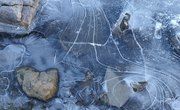
Metamorphic rocks are the third major type of rock, the other two being igneous and sedimentary. Because of how they are formed, metamorphic rocks constitute a great deal of the bedrock in Earth's crust. Many precious materials, such as marble and many types of gemstones, including diamonds, are formed by the metamorphic process.
Formed Underground
The layers of rock that constitute Earth's surface are continually added to by various geological processes. Over time, the weight of the surface pushes down old layers, closer to the planet's core. In this process, heat, pressure and gravity exert force on these rock layers, gradually transforming the character of these rock formations.
Sheets, Slabs and Slates
Depending on the composition of the rocks being metamorphosed, there are two major types of metamorphic texture. Foliated metamorphic rocks are arranged in sheets or planes, meaning that the composition of the rocks is relatively uniform and disperses fairly evenly due to pressure. Undifferentiated or "non-foliated" metamorphic rocks, like coal, often crystallize unevenly due to the impurities in these rocks.
Formed from Other Types
Metamorphic rocks are formed from igneous and sedimentary rocks. In volcanic and seismic activity, the cooling of magma creates igneous rocks, which are buried by further igneous rock formation, soil and vegetation. Sedimentary rocks are largely formed by erosion of other types of rocks, most dramatically seen in the form of beach sand, which represents millennia of weathering and erosion.
Types of Metamorphosis
Different types of geological events and locations produce different types of metamorphism. Contact metamorphism occurs when the extreme heat of igneous rock touches a cooler rock surface. Fault metamorphism occurs when seismic activity causes crust plates to jut against each other, causing extreme pressure activity.
References
About the Author
Based in the New York City Metro area, James Woudon began writing in 1999. He is a former editor of the college publication, "John Doe Comics." Woudon holds a Bachelor of Arts in communications from Rutgers University.
Photo Credits
Photos.com/Photos.com/Getty Images
